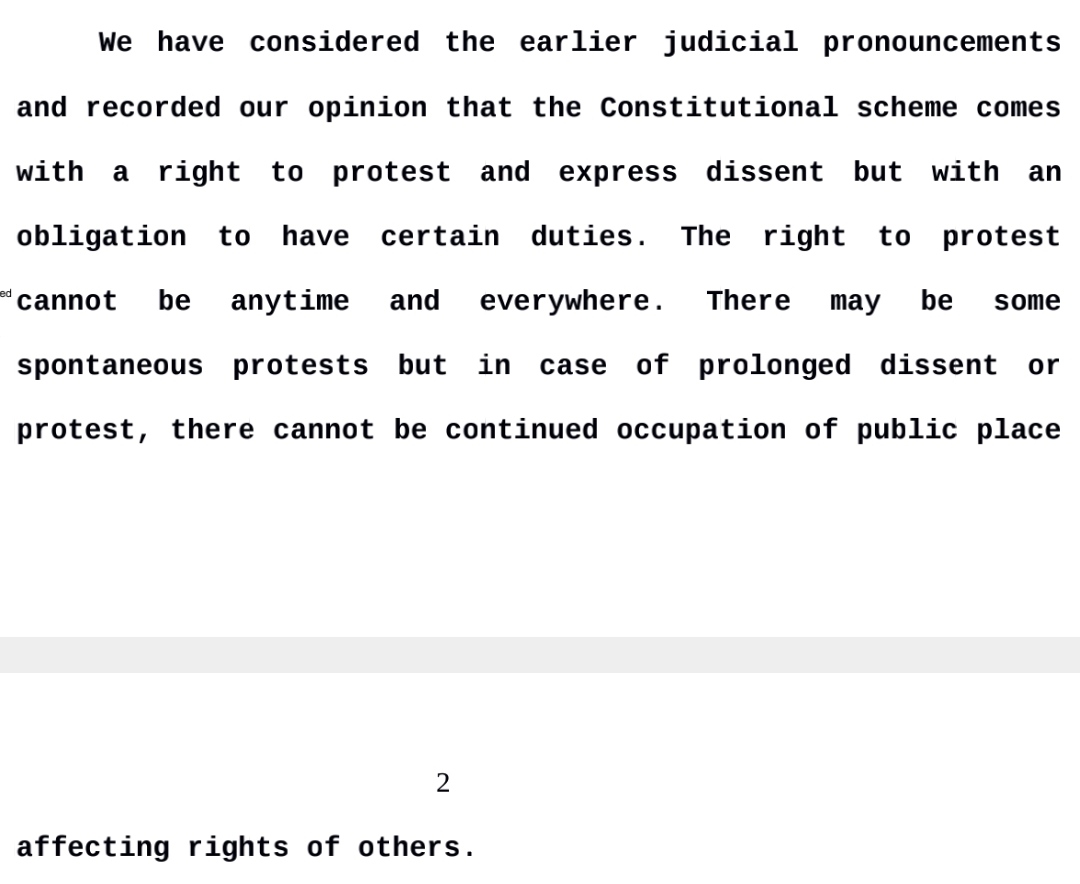When will the Supreme Court learn to do better legal reasoning? So many problems with this order which dismisses the Shaheen Bagh review petitions. Thread/rant.
As usual, the Court throws one vague and axiomatic statement after another. The protest right comes with "certain" duties. Cannot be "anytime" and "everywhere". "Spontaneous" is okay but "prolonged" and "continued occupation" is not.
But who will address the hard questions?
But who will address the hard questions?
What are the exact duties that come with the right to protest, and where are these duties laid out in the Constitution? Is there a principled basis at all for this "certain duties" narrative, or will the Supreme Court invent a random "duty" everytime it deals with a protest?
I quite understand that since this is an order passed in a review petition, the Court is not required to lay down new doctrine here. It is only required to say why the main judgment (which is being challenged) is sound. But given that the main judgment is equally hopeless...
( https://main.sci.gov.in/supremecourt/2020/2418/2418_2020_36_1501_24294_Judgement_07-Oct-2020.pdf) the Court ought to have sincerely engaged with the issues involved. Even in the main judgment, based on vague axioms and without any principled reasoning, the Court had ordered that protests can only be in "designated" places (jantar mantar etc.).
To be clear, the Court did offer some justification. It said that the right to protest must be "balanced" against others' fundamental right to mobility -- without stating the provision in which the fundamental right to mobility is found. Presumably Art.19(1)(d) and/or Art.21.
But here's the problem: rather than "balancing" the two fundamental rights, the Court -- by directing all protests to be held at jantar mantar etc. -- effectively holds that mobility *trumps* protest rights. Nothing is being *balanced*.
Anyway, that's the genesis of the Court saying in the review order that protests cannot be "anytime and everywhere".
But what's up with the next sentence? How are "spontaneous" protests suddenly acceptable to the Court? A new finding contrary to the main judgment.
But what's up with the next sentence? How are "spontaneous" protests suddenly acceptable to the Court? A new finding contrary to the main judgment.
One problem, of course, is separating the "spontaneous" from the "prolonged". Does it have to be the same people sitting continuously at the same place in order to constitute a "prolonged" protest? What if we keep shifting sites? What if the protestors keep changing? Or both?
But the more fundamental issue, again, is that the Court offers no principled basis for the spontaneous v prolonged distinction (spontaneous protests can block traffic too!) Maybe such a basis exists. But the Court doesn't feel the need to find it, and that's the problem.
This is only an example of the Supreme Court's usual approach to rights adjudication. Rather than a constitutional court bound by constitutional text and principles, it acts like an equity court -- sometimes a panchayat -- governed by a "my heart says" approach. As Scalia said:
"If the courts are free to write the Constitution anew, they will, by God, write it the way the majority wants.... This, of course, is the end of the Bill of Rights, whose meaning will be committed to the very body it was meant to protect against: the majority."
The Shaheen Bagh case is a good example of such a majoritarian ruling. Protestors are causing trouble to the commuters. We should have zero tolerance to trouble being caused to commuters. Protest rights ought not to allow inconvenience to commuters. It is ordered accordingly.
This tendency to "innovate" is a larger issue, one of judicial culture. It cuts both ways. Sometimes it leads us to the seemingly good outcomes like PILs, manifest arbitrariness, catch-all nature of Art.21 and so on. But it also comes with costs like these.

 Read on Twitter
Read on Twitter


